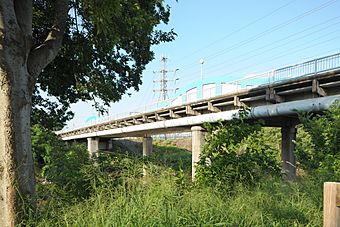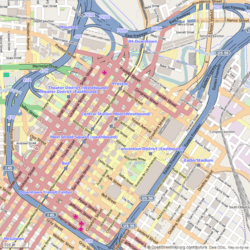McKee Street Bridge facts for kids
Quick facts for kids |
|
|
McKee Street Bridge
|
|

The bridge in 2010
|
|
| Location | McKee St. and Buffalo Bayou, Houston, Texas |
|---|---|
| Area | less than one acre |
| Built | 1932 |
| Built by | Don Hall Constructors, Inc. |
| Architect | Joseph Gordon (J.G) McKenzie |
| Architectural style | Moderne |
| MPS | Historic Bridges of Texas MPS |
| NRHP reference No. | 02000729 |
| Added to NRHP | September 3, 2002 |
The McKee Street Bridge is a cool old bridge that crosses the Buffalo Bayou in Houston, Texas. It was built in 1932 and is made of strong concrete. This bridge connects two neighborhoods, the Second and Fifth Wards, just northeast of downtown Houston. Because it's so special, it was added to the National Register of Historic Places in 2002.
About the McKee Street Bridge
What the Bridge Looks Like
The McKee Street Bridge is about 290 feet long. It has three main sections, called spans. Two sections are 85 feet long, and the middle one is 120 feet long. This long middle section goes over the main part of the Buffalo Bayou.
The bridge is high enough for boats to pass underneath. It gives 42 feet of space from the water to the bottom of the bridge. Since the bayou bends here, the bridge was designed to give 100 feet of space for boats to pass easily.
The road on top of the bridge is made of brick. These bricks are laid on a layer of sand. The concrete parts that hold the bridge up are curved. This curved shape looks nice and also helps the bridge carry its weight. In 1985, a local artist painted the bridge in bright colors like aquamarine, purple, and lavender.
A Look Back at the Bridge's History
The Buffalo Bayou was a very important waterway for trade. As early as 1836, people used it to move goods between Houston and Galveston Bay. Steamboat services started there in 1837. By the early 1900s, the area around McKee Street was a busy place for factories and businesses.
More cars, trains, and boats meant Houston needed more and better bridges. The first bridge at McKee Street was built in 1908. It was a steel bridge that could swing open. A motor would move it out of the way so boats could pass through.
The current McKee Street Bridge was built in 1932. It replaced the older 1908 bridge, which had been taken down in 1928. The government had special rules for how tall and wide the new bridge had to be. Also, McKee Street meets the bayou at a tricky angle. This meant the new bridge had to be very unique for its time.
The concrete parts of the bridge, called girders, were designed in a special way. Instead of being straight, they were shaped to match how the bridge would bend under weight. This smart design saved money and allowed for a longer main section. In fact, the middle section was the longest concrete girder span of its kind back then. Its wavy, up-and-down shape had never been used before. The bridge was built between 1931 and 1932. It cost $122,000, which also included taking down the old bridge.




